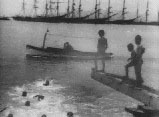Grant-Kohrs Ranch National Historic Site [MT]
Once the headquarters of a 10-million-acre cattle empire, Grant-Kohrs Ranch National Historic Site is a working cattle ranch that commemorates the role of cattlemen in American history. Among the original buildings on the site are the historic ranch house, the bunkhouse, the blacksmith shop, horse barns, and cattle sheds. The main ranch house was built by Johnny Grant (18311907) in 1862. It was a trading post downstairs and a residence upstairs. In 1866 he sold the ranch to Conrad Kohrs (18351920) who became known as the "Cattle King" in Montana. Site collections number 23,000-plus artifacts, consisting of everyday objects once used by the people who lived and worked at this ranch from the 1860s to the 1960s. Highlights include historic wagons and buggies.
The site offers exhibits, walking trails, self-guided tours, guided wagon and house tours, a variety of themed talks, period rooms, ranger-led in-classroom presentations, a traveling trunk, archives accessible by appointment, and an annual teacher workshop. The website offers lesson plans geared towards Montana educational standards, photo galleries, and a video on the use of a beaverslide hay stacker.
